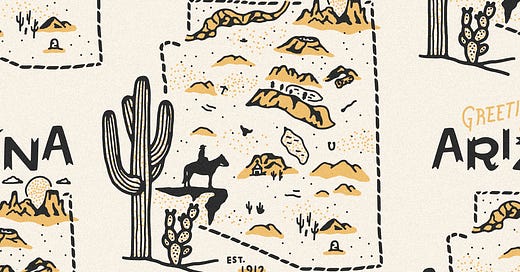The Epitome of Dysfunction
How Arizona's independent commission diluted the voting power of indigenous peoples and other communities of interest to benefit Republicans running for Congress.
The Grand Canyon State has always had an independent streak. In 2016, the state overwhelmingly re-elected Republican Senator John McCain, who subsequently crossed party lines to cast the deciding vote against repealing the Affordable Care Act. In 2018, the state elected Senator Kyrsten Sinema, a moderate Democrat who angered the base with her opposition to repealing the filibuster rule. In 2022, the state rejected the ultraconservative hardliner Blake Masters to resoundingly re-elect Democratic Senator Mark Kelly, even as his party faced mixed results nationwide.
That’s why it should come as no shock that Arizona conducts its redistricting process via an independent commission. However, this process isn’t infallible. During the 2012 redistricting cycle, the five-member commission (composed of two Democrats, two Republicans, and an independent tie-breaker) voted 3-2 to adopt a Congressional map, with the tie-breaker supporting the Democratic commissioners. While this map aged well toward the decade's end, many people rightfully criticized its initial tendency to benefit Democrats. In 2012, Republicans only won 4 out of 9 districts despite crushing Democrats in the Congressional popular vote by 8.5 points.
Unfortunately, a similar dynamic occurred in the 2022 redistricting cycle, this time to benefit Republicans. The commission’s independent tie-breaker Erika Neuberg voted alongside the two Republican commissioners to implement a new Congressional map with major changes. Firstly, Indigenous voters predominantly from the Navajo and Apache tribes were dealt a devastating blow as their northeastern competitive district was completely revamped. Replacing competitive areas within Maricopa County, the commission added staunchly conservative Yavapai County to the district, which all but guaranteed that Democratic-leaning Arizona natives wouldn’t be able to elect a representative of their choice. Furthermore, the commission carved out Democratic precincts in Cochise and Pima counties from former Representative Ann Kirkpatrick’s district. This shifted the seat from one that Joe Biden won comfortably to one that he won by the skin of his teeth, allowing Republicans to narrowly flip it in the 2022 midterm elections.
Below is a visual from Wikipedia showcasing the impact of this new map in the most recent election. Despite concurrently winning almost every single statewide office, Democrats only won a third of the Congressional seats (3/9).
A Fair Alternative
What really makes this map truly frustrating is that it’s a breeze to create a map that’s superior in communities of interest, compactness, and proportionality. Here’s an alternative I created using Davesredistricting:
In this map, Democrats and Republicans both have ample opportunities to claim a majority of districts. While Democrats have a district in Northern Phoenix that marginally leans in their direction, Republicans have a slight edge in the fiercely competitive Navajo-Apache district that spans the northeast. There are two other mildly competitive districts in Phoenix, along with a semi-competitive district based around Cochise County and the Tuscon suburbs. Depending on the year and trends in suburban areas, many of these seats could foreseeably flip in either direction. Davesredistricting gives it a higher compactness score than the status quo and a perfect 100% score on proportionality.
What does the Future Hold?
Unfortunately, it seems like the commission is here to stay for the foreseeable future. In the past three redistricting cycles since its inception, the commission has failed in its mission of equality to benefit one political party at the expense of voters from all backgrounds. Last cycle, it helped Democrats and stifled Republican representation. This cycle, it helped Republicans and stifled Democrat representation. During this ridiculous partisan back and forth, Indigenous tribes have often found themselves split apart or diluted, preventing their interests from being represented in the United States Congress. If legislators are serious about solving the dysfunction that pervades Arizona redistricting, they should replicate Michigan’s widely praised independent commission system. Until this happens, it’s up to ordinary Arizona citizens to continue advocating for equal representation in their political maps.
(cover drawing by Mark Johnson on Dribble)




